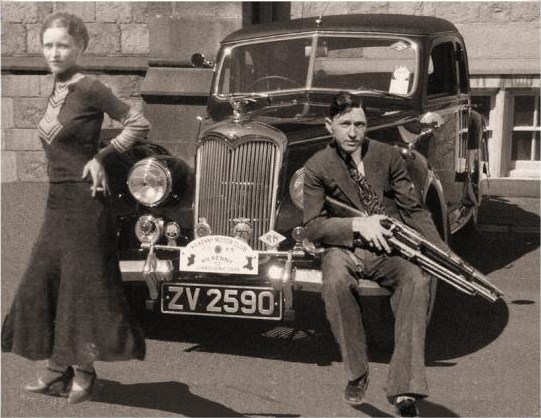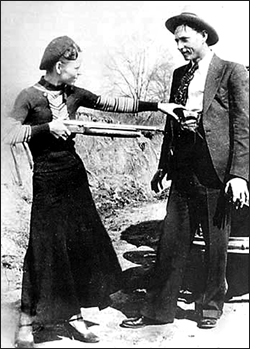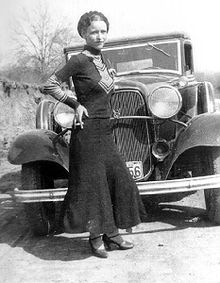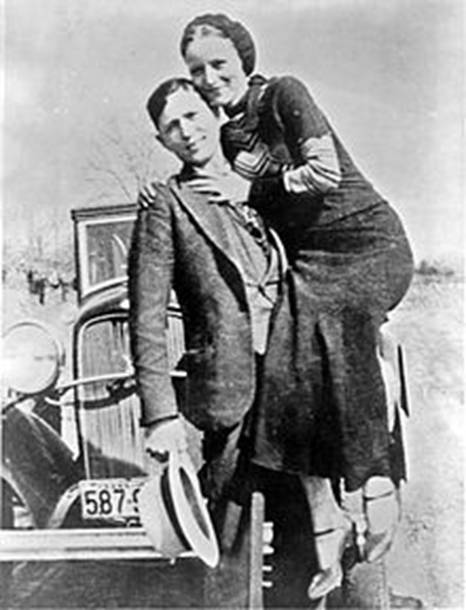Did Bonnie & Clyde Play the Dulcimer?

As many people know, the notorious bank robbers Bonnie and Clyde were gunned down in 1934 in Bienville Parish, Louisiana by a posse led by lawman Frank Hammer. Among the vast array of shotguns, handguns, automatic rifles, ammunition and license plates, the posse found a “strange music fiddle” that miraculously survived the slaughter undamaged. Historians have recently identified this mysterious instrument as a 3-string Appalachian dulcimer.
It is well documented that Bonnie Parker was a talented singer with a sweet voice who was scheduled to star in a Broadway musical in 1933. However, due to her status as a wanted felon, she was unable to fulfill the terms of her contract. It was not known until recently that Bonnie Parker was also a talented and highly innovative dulcimer player.
While restoring and cataloging tapes made by famous folksong recorder Ralph Peer, attendants at the Library of Congress discovered that the infamous couple were actually recorded during an undated Peer session in Dallas. Bonnie, along with her musical partner Clyde on lead vocals, recorded three incredible tracks that foreshadowed coming musical trends for years. What makes these tracks even more impressive is that the only musical accompaniment is Bonnie’s three string dulcimer with an occasional harmonica break by Clyde. Although the harmonies and lead vocals are soulful and captivating, it is the remarkable dulcimer innovations of Bonnie Parker that truly capture the listener’s attention.
Bonnie’s playing is reminiscent of and comparable in innovation to the great bluesman Robert Johnson. Although Peer’s notes clearly indicate that “Bony Parker played a ducimore musical instrument” alone on the recording, the casual listener would swear they were hearing an entire string band. While singing harmony and playing intricate counterpoint melodies with jazz style chord inversions, Bonnie somehow manages to use the dulcimer as a drum by tapping out primal but sophisticated rhythms on the soundbox.

Famed musicologist Professor Herbert Nositall suggests that the incredible depth of Bonnie’s playing is equal in many respects to the best work of great masters such as Beethoven or Mozart. He states emphatically, “Bonnie seems to have an innate and ingenious ability to make up melodies and counterpoint harmonies on the spot. The musical intricacy and simple beauty of these movements indicate that she would have been equally at home composing major symphonies as well as playing the dulcimer. In another time, Bonnie and Clyde may have been another Rodgers and Hammerstein or Lennon and McCartney. ”
Of the three songs recorded by Bonnie and Clyde, the most interesting is “V-Eight Ford”. This rollicking, hard driving tour-de-force is an epic masterpiece describing the couples harrowing existence and hilarious escapades. Music professor Will E. Playmore says, “There is no doubt that this is the first Rock-N-Roll style song ever recorded. If you listen to the rhythm that Bonnie taps out on the dulcimer and the “double stop” style guitar based riffs she plays between verses, it is obvious that Chuck Berry either heard Bonnie Parker play the dulcimer or learned from someone who did. In fact, it appears that much of the early rock and roll, rockabilly, and Chicago blues music of the 50”s is based either directly on this song or is derived from it in some fashion. So it is not a stretch to say that Bonnie and Clyde invented Rock & Roll - only they played it on a dulcimer instead of a guitar.” Professor Playmore now teaches a course at Harvard called “The True Origins of Rock and Roll.” The core purpose of the class is to study the recording of “V-Eight Ford.”
The next song Peer recorded is “Gangster- Ain’t Got No Toe”. This song is basically a blues shout that veers off into a call and response similar to modern rap music. With Bonnie thumping out a funk style rhythm, Clyde raps and rhymes about evading the police and even mentions “drive-bys” and several other terms appropriated by modern rappers.

As Clyde raps, Bonnie holds down a solid rhythm and answers his calls in a sing song patter that is virtually identical to that used today in “Gangsta Rap”. For instance, when Clyde bemoans the hardships of running for his life, shooting it out with police and cutting off his toe in Huntsville prison, Bonnie can be heard in the background thumping out a hypnotic but ever-changing rhythm, while playing a series of intricate chords and chanting phrases such as “Whoop, whoop – where’d it go, my old man ain’t got no toe”.
When discussing the origins of rap music in People magazine, the famous and infamous rap producer J.J. Cool Style stated, “It be obvious to me that the first rap record was “Gangsta” by Bonnie and Clyde. It’s got the groove, it’s got the attitude, -%*X# man - it’s what rap is all about. You got Bonnie back there thumpin’ that thang and playing them crazy chords. Add a few cuss words and you could sell a million tomorrow. I tell you man, I look for a lot of these dudes to start using dulcimers. Man I’m thinkin’‘bout doing a whole CD of dulcimer rap just to get ahead of the curve.”
The third and last song recorded by Bonnie and Clyde is titled “Where Do We Go?” In this song they pull out all the stops. It begins slowly with Clyde singing in a melodic Irish style tenor accompanied by haunting background “Oh’s” and “Ah’s” sung in an angelic soprano by Bonnie. The dulcimer accompaniment is clean and simple with concise but intricate chording punctuated by single note fills that are anticipative of the bass runs of a fine bluegrass guitar player or the baroque intricacies of a parlor band. As the song progresses it becomes more and more urgent and insistent - eventually verging on an extreme intensity that is frankly shocking. By the third verse, plaintive calls of “Where do we go, where do we go, where do we go now…” underscore the hopelessness of the couple’s situation. At the end of Clyde’s pleads, Bonnie goes into a long extended dulcimer solo. The sounds that Bonnie conjures up are startling, amazing and impossible to define. During the four and one-half minute solo, Bonnie makes the dulcimer sing like no one has before or likely ever will again. There are sections where she imitates the sounds of barking dogs , seagulls flying over the ocean shore, train whistles … and a multitude of other sounds that must spring from her own indomitable soul since there is no earthly comparison or vantage point.

Famous Los Angeles studio guitarist Billy Longfinger was recently quoted in Guitar Player magazine, “After hearing the Bonnie Parker tapes, I no longer think of guys like Hendrix or Van Halen as innovators but more as imitators. It’s obvious to me that most of the licks they’re playing were either wholly or partially taken from Bonnie’s licks on “Where Do We Go Now.” The only difference is that they are doing it with an electric guitar and a wall of Marshall Amplifiers and she was doing it all on a three string dulcimer. I doubt that anyone will ever figure out how she got all them sounds out of a little three string box. But one thing’s for sure… if she was alive today – she would be bigger than Elvis.”
It is obvious that Bonnie, and to a lesser extent Clyde, were immensely talented musicians who could have easily earned a good living from their music even during the depression. But for some reason, they turned to a life of crime. Maybe their music was too far ahead of its time and they thought they could never be accepted by the general population. Maybe this despair drove them to robbery instead of recording. The world will probably never know. But if they had only had the conviction of their art, then maybe they would not have had the conviction of the judicial system. So if there is a lesson to be learned from the life of Bonnie and Clyde, it is that if you focus on playing your dulcimer it may save you from a life of crime, serious time in prison and subsequently being gunned down in a murderous, slaughtering, bloody hail of bullets. This is not a bad tradeoff for a few hours spent playing the dulcimer!